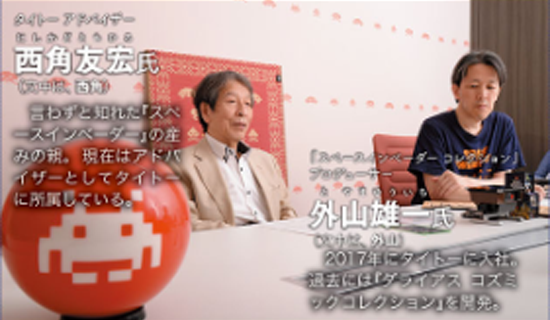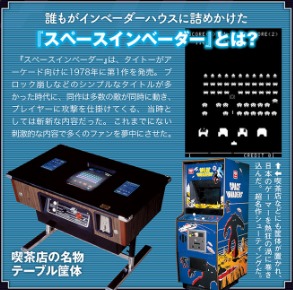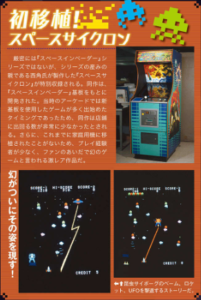To commemorate the announcement of this new title, we have an interview with the original Space Invaders creator Tomohiro Nishikado, as well as Yuuichi Toyama, who is handling the collection. They tell us some behind the scenes stories about the legendary game that created such an enormous boom, as well as some interesting things about the collection. Pay close attention to this first hand account from the person that helped create game culture as we know it today.
Tomohiro Nishikado (Taito Advisor) – The creator of Space Invaders needs no introduction. He currently works as an adviser for Taito.
Yuuichi Toyama (Producer of the Space Invaders Invincible Collection) – He joined Taito in 2017, and has previously worked on the Darius Cozmic Collection.
The Game That Caused a Move From Electromechanical to Video Games
As of 2018, it’s been 40 years since the first Space Invaders game. Mr. Nishikado, do you have a lot of emotional attachment to it, being the developer?
(Nishikado) I continue being surprised at how much time has passed, every 10 years since its release.
(Toyama) Development on the collection was supposed to have begun last year, since that was the 40th anniversary. However it was delayed, so we’re just now announcing it.
(Nishikado) It was a phenomenon back in the day, but of course there was also a period where everyone was sick of Space Invaders. But since it’s made it this far, I think that makes it a curio or is an acknowledgement that it still has value despite its age. And that makes me very happy.
What do you think, Mr. Toyama?
(Toyama) The first Space Invaders machines came out when I was in grade school, but I was into it before it became so popular. That’s because I really loved arcade games. Being able to work on a game series like this one fills me with emotion as both a developer and a huge fan of the series.
Could we hear some stories about the development of Space Invaders?
(Nishikado) Before creating Space Invaders I made electromechanical games. I’d made a bunch of them, but video games had gradually overtaken them as the cutting edge technology. And so I developed Space Invaders at Taito, but even now I think that it was the culmination of my design experience.
Mr. Nishikado, did you originally join Taito as a game developer?
(Nishikado) I joined the company as someone who lays out circuit boards.
(Toyama) At that time the people who designed cabinets and circuit boards worked near the programmers. So it was advantageous to be able to do both.
(Nishikado) I worked on the exterior mechanics of those electromechanical games. But then they told me “Nishikado, you’re good with circuit boards. Try making a video game!”. And that’s how I got started in them.
(Toyama) Do you remember feeling a lot of pressure in needing to be able to program?
(Nishikado) Yes. I studied it a bit in college, but of course since it was school work I didn’t find it very interesting, and therefore didn’t remember any of it (Laughs) But I had to remember how to program if I was going to make a video game. So after joining the company I started re-learning it. America was further along when it came to game development techniques at that time, so I referenced some of their games as I was learning.
He Made Space Invaders By Himself!?
What was game development like back then?
(Nishikado) I was in charge of everything from planning to programming myself. There were other game developers on staff, but one would person would concentrate on one title at a time, so we didn’t really interact very much.
You made the game all by yourself?! Nowadays that’s unthinkable!
(Nishikado) I guess it is (Laughs) I’m the type of person who would rather try to do something himself than have someone else do it, so it was very fun from an engineering perspective. I was able to make all of the decisions myself, and development went very smoothly.
Of course game development wasn’t like it is now, but I imagined it to be a lot of fumbling around for solutions.
(Nishikado) I had to create the OS that ran the game myself as well, so it was repeated trial and error.
(Toyama) Nowadays there are development aids like game engines and middle-ware, but back then you issued commands to the CPU on the board directly, and you were writing programs that displayed things to the screen. So it was completely different.
(Nishikado) The board used in Space Invaders was very high-tech for the time. But the processing speed was still slow, and I wasn’t able to make the graphics move the way I thought I would. So in that way, the development was really difficult.
Space Invaders became such a hit shortly after release as to be called a social phenomenon. How did seeing that happen make you feel?
(Nishikado) Arcade games could sometimes be found in places like bowling alleys and hot spring bath houses. But once Space Invaders was released, arcades were created and called “Invader Houses”. So the locations at which you could find machines very clearly expanded.
Since it was so popular, counterfeit boards became a problem back then.
(Toyama) Even if you were thinking of buying a Space Invaders board back then because it was so popular, you basically couldn’t because production just couldn’t keep up with demand. So I guess counterfeit boards were inevitable…
(Nishikado) The role of us developers in the project was already done at that point, so it didn’t bother us much. But I think it must have been very hard for the manufacturing and sales people.
From what I understand, it wasn’t uncommon for the box that the coins go into when inserted to get too full to where you couldn’t get the machine open.
(Nishikado) We made the coin box four times bigger than any up to that point, but even that wasn’t enough.
Space Invaders machines weren’t just found in arcades, but also cafes too.
(Nishikado) Games in cafes tended to be cocktail style cabinets. The people running them did it that way because it would allow them to fit more cabinets in a smaller space. We didn’t make them with cafes in mind specifically, but they were able to fit into all kinds of different places.
How did you view the Space Invaders boom as the developer of the game?
(Nishikado) After I finished the development of Space Invaders, all I could think about was how I wished I could have used a board with better graphical capabilities. But I was pretty unaffected by the whole thing, only going so far as to think “Wow, looks like it got pretty popular”. I actually never even went to an “Invader House”.
The Incredibly Rare Game: Space Cyclone!
A very important point about this collection is that it will contain Space Cyclone, right?
(Toyama) I wanted to make sure that it was included. I grew up in Nagasaki, and since there weren’t very many cabinets shipped, my hometown didn’t get any. I didn’t know that the title even existed at the time, and actually heard about it for the first time at an event that Mr. Nishikado spoke at. Luckily Taito still has one of the original boards, so we’re lending it to the developer to port from.
(Nishikado) The big draw of Space Cyclone is that it had voice samples, and games with voice in them were very cutting edge at the time. The voice samples were provided by a female employee who sat next to me back when I was a developer.
Staff providing the voices for games was a very common occurrence in game development back then.
(Nishikado ) That’s true (Laughs) She wasn’t a pro or anything, so her voice work is a bit plain.
(Toyama) When the enemy characters descend to the bottom of the screen and the rocket is ready, she says “Ready to launch!”, right?
(Nishikado) The systems in place and the flow of the game itself were really good, but unfortunately it was just too hard. And that’s why it wasn’t very popular (Laughs) I don’t play very many games myself, but we did get feedback from testers and tuned the game balance based on their feedback. The testers at that time were very familiar with video games, and kept telling me that it was too easy as it was. So I kept gradually making it more and more difficult. And people on the business side told me that people will put in more money if it’s difficult, and that was great. So it was released in that state.
At that time there were definitely a lot of players that had gotten good at Space Invaders, so places that bought arcade games might be in trouble if the difficulty wasn’t increased.
(Nishikado) But if you make it too much more difficult, first-timers won’t be able to play it. And that’s why balancing it was so difficult.
This collection is full of titles that you have so many memories of, Mr. Nishikado, but I’d like to know what the highlights of it are from Mr. Toyama’s perspective as the producer.
(Toyama) Of course it means that these games will now be playable on modern hardware, but I’d like to put particularly emphasis on the sound. Modern games have sound chips on the boards, so it’s common sense that you send out a signal and get the corresponding sound. However, Space Invaders came from a time where that wasn’t the case.
There were subtle differences between cabinets, right?
(Toyama) Even though the cabinets themselves were all the same, the condition of them and the power source that it was connected to could cause differences in the output. So I think what Space Invaders is remembered as sounding like is different depending on the person. Katsuhisa Ishikawa from Zuntata (Taito’s sound team) is the one deciding on what the actual sound of Space Invaders is. So everyone who plays the collection, please compare what it sounds like to what you remember the game sounding like.
The collection will feature both the black and white and color versions of Space Invaders, but will the cellophane version be included as well?
(Toyama) Well…it has been ported for past collections. So I suppose it would be bad to not include it.
(Nishikado) If it is included, I’d want the gaps in the cellophane to be reproduced as well.
(Laughs) I’d be very happy as a fan if that level of detail was put into it. These games will be playable on modern hardware, so younger people who weren’t around back then will get the chance to play them as well.
(Nishikado) I really hope that they play them and find something interesting about them. These days there are so many games to play, and I’m sure those games are all amazing. But I don’t think that the true quality and fun of these games has changed over time. Every game on this collection will still be fun to play now. I’d really like for younger people to try them out.
(Toyama) I hope people play this collection and think back on how things used to be back during this time.


